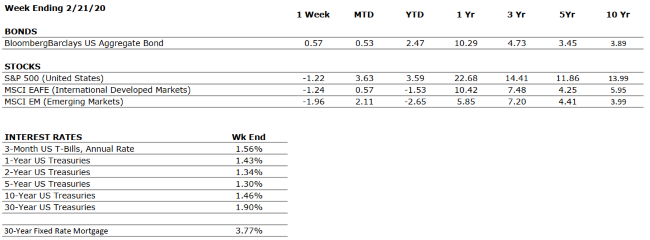by Connor Darrell CFA, Assistant
Vice President – Head of Investments
It
was a “risk off” week for global markets as stocks retreated from their highs
and bonds generated positive returns amid growing fears of further spreading of
the coronavirus. Many of those fears were realized over the weekend as evidence
emerged of a substantial increase in the number of cases outside of mainland
China, particularly in Italy, South Korea, and Iran. We have discussed in
previous iterations of The Weekly Commentary that two key areas we are focusing
on with respect to evaluating the risks posed by the virus are contagion and
severity. In our assessment of contagion, our internal discussions have focused
on evaluating whether containment efforts in China would be successful in
keeping the virus from spreading beyond Chinese borders. The significant
increase in cases outside of China over the weekend suggests to us that these
measures have likely failed. As a result, we are increasing our assessment of
geopolitical risks within our economic Heat Map from “Negative” to “Very
Negative”. Below, we provide further
details of our current thinking.
Coronavirus Update: How Should Investors Be Approaching the Issue?
In our view, it is becoming increasingly likely that the spread of this disease will reach pandemic status, and many in the scientific community believe it is already at that point. There is of course a significant symbolic weight behind the word ‘pandemic’, and the simple reclassification of the current state of the coronavirus situation has the potential to strike fear into the general public. But by definition, the World Health Organization (WHO) defines a pandemic as simply “the worldwide spread of a new disease.” There is no specific standard that must be met with respect to the severity of the disease or its financial impact. It just needs to spread globally in order to reach the status of pandemic. We think that this is an important point to make, because that leaves open the very real possibility that a disease reaches pandemic status without the need for mass hysteria. In fact, the 2009 strain of H1N1 flu reached pandemic status with more than 60 million cases in the U.S. alone; and few if any of us look back at that pandemic and associate it with intense fear.
As investors, it is imperative that we disentangle our concerns for the near-term impacts on public health from our long-term expectations for markets. As a financial planning firm, we are long-term investors by nature. Everything we do for clients stems from the financial plan, which is constructed through a process that is designed to account for bouts of market volatility stemming from exogenous shocks (such as a pandemic virus) that may happen over the course of the implementation period. The beauty of the technology used by financial planners when constructing long-term plans is that we can test the resiliency of our plans across different scenarios, and those possibilities can be baked into the recommendations as well as into the construction of client portfolios. In our view, as long as a financial plan is properly constructed in a way that it aligns with an investor’s long-term goals, there should be no need for the investor to become overly concerned with the potential near-term impacts of these types of risks.
The important assumption that is made in the paragraph above is that the impacts of the coronavirus will be near-term in nature. There are multiple reasons that we continue to operate based on this assumption. The first relates to the severity of the disease. Looking back through history, there is really only one pandemic illness over the last 100+ years that was severe enough to unilaterally push the global economy into recession; and that was the Spanish Influenza of 1918. When we compare the data currently available on the coronavirus with what we know about the Spanish Flu, it becomes immediately clear that the two diseases are miles apart in terms of their severity. There are some conflicting estimates of the true severity of the Spanish Flu, but most suggest a mortality rate somewhere in the range of 10-20%, with significantly higher rates among certain age cohorts. The severity of the coronavirus remains somewhat difficult to fully evaluate given that it is an ongoing situation, but the current estimate is a mortality rate somewhere around 3%. Furthermore, the Spanish Flu is infamous among epidemiologists for being particularly deadly among younger, healthier adults. The data we have thus far regarding the coronavirus is that the mortality rates are significantly higher among older patients with compromised immune systems, much like the seasonal flu.
The second reason we continue to operate under the assumption of short-term impacts is recent history. An evaluation of several of the most recent viral epidemics (including SARS, H1N1, Ebola, and MERS) reveals that both economic and market impacts of the diseases could be measured in quarters rather than years. It would take a particularly deadly and long-lasting disease to alter the trajectory of economic output worldwide for more than a couple of quarters, and until we see evidence that this disease is capable of that, we are not sounding the alarm for investors to run for cover. It will continue to be important for investors to keep themselves informed of new developments, and it is our intention to provide as many updates as we can through The Weekly Commentary, but long-term investors should continue operating through a long-term lens.
There remains the distinct possibility that additional news flow related to the disease could continue to weigh on equity markets, so investors who have near-term spending needs and plan to draw money from their portfolios within a year should make sure they have that money available in a low-risk investment vehicle. But for many others, an adjustment to the investment strategy should not be necessary. If you have specific questions related to your situation or a change in circumstances that warrants further consideration, your financial advisor is available to help you evaluate what the best course of action might be for your unique situation.




